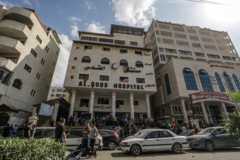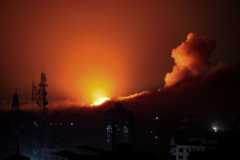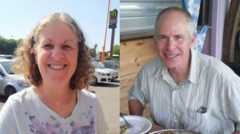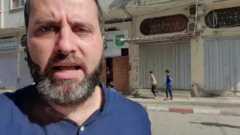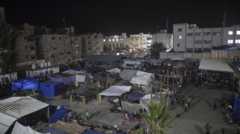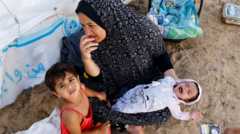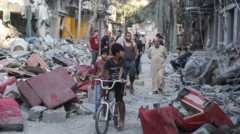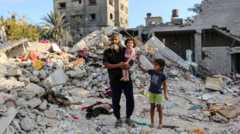With updates from Rushdi Abualouf in Gaza; Jeremy Bowen, Anna Foster and Lucy Williamson in southern Israel; Lyse Doucet, Yolande Knell, Paul Adams, Wyre Davies and Alice Cuddy in Jerusalem; and Hugo Bachega in southern Lebanon
-
-
UK MP suspended, government employee sacked for Israel-Gaza comments
Over in the UK, a government employee was sacked and a Labour MP was suspended for making comments about the situation in Israel and Gaza.
Ministerial aide Paul Bristow wrote a letter to the prime minister last week and said “a permanent ceasefire” would save lives and allow aid to reach those who needed it most. Downing Street said the comments “were not consistent with the principles of collective responsibility”.
Andy McDonald was suspended as Labour MP for using the phrase “between the river and the sea” in a speech at a pro-Palestinian rally. Critics of a chant which contains the phrase argue it implicitly calls for the destruction of Israel, and the Labour party said the comments were “deeply offensive”.
-
31 journalists have been killed in Israel-Hamas war – CPJ
At least 31 journalists have been killed covering the conflict between Israel and Hamas, according to the latest count from the Committee to Protect Journalists (CPJ).
Of the casualties, 26 were Palestinian, 4 Israeli, and 1 Lebanese. A further 8 journalists have been reported injured, while 9 are considered missing or detained, the CPJ says.
“Journalists in Gaza face particularly high risks as they try to cover the conflict in the face of an Israeli ground assault… devastating Israeli airstrikes, disrupted communications, and extensive power outages,” the organisation said in a statement on Monday.
Among the dead are Roshdi Sarraj – a well-known Palestinian filmmaker – and Issam Abdallah, a Beirut-based videographer for Reuters, who was killed near the Lebanon border by shelling coming from the direction of Israel, according to the CPJ. The IDF said it was investigating the claim.
The IDF also told Reuters and the Agence France Press news agencies that it could not guarantee the safety of their journalists operating in the Gaza Strip, after they had sought assurances that their employees would not be harmed by Israeli strikes, according to Reuters.
-
-
IDF says it struck ‘Hezbollah infrastructure’ in Lebanon
The Israel Defense Forces (IDF) has released footage showing what it says is an airstrike targeting Hezbollah’s infrastructure in Lebanon.
“IAF fighter jets struck Hezbollah terrorist infrastructure including weapons, posts and sites in Lebanon,” the IDF said on Tuesday in a post on X.
Hezbollah, a powerful Lebanese militia backed by Iran and a Hamas ally, has exchanged cross-border fire with the IDF since 7 October.
-
Negotiator says hostage video poses ‘extraordinary dilemma’
 Copyright: BBC
Copyright: BBCGershon Baskin – who helped secure the release of Israeli soldier Gilad Shalit from Hamas in 2011 – says the hostage video that emerged on Monday presents an “extraordinary dilemma” for Israeli decision-makers.
Speaking to BBC News, he says Hamas wants an “all for all” deal – meaning a trade of all the hostages it holds for some 6,000 to 7,000 Palestinian prisoners in Israeli jails.
Baskin says: “Doing an agreement for part of the (group of) hostages – the civilians, the women, the children, the elderly – would still leave tens of hostages in Hamas’s hands; probably 50, 60 or 70.”
He adds: “We don’t know the exact number of hostages that Hamas considers to be soldiers – whether they are or not – and that’s an impossible reality for Israel to deal with as well.”
He says most of the Palestinian prisoners in Israeli jails are from the West Bank, and most are not members of Hamas.
-
Protesters occupy Canadian government offices
 Copyright: Reuters
Copyright: ReutersActivists across Canada have occupied offices belonging to high-ranking members of the government as they demand that MPs call for a ceasefire.
Among the offices occupied on Monday were those belonging to Defence Minister Bill Blair and Deputy Prime Minister Chrystia Freeland.
The protests took place at 17 offices in 12 cities across the country, according to the Montreal Gazette.
“We’re here to demand that the Canadian government call for an immediate ceasefire and for an end to the almost 16-year long blockade at the Gaza Strip and to end Canadian complicity with Israel,” one protester in Toronto told Reuters.
Protesters there held signs showing Palestinians who have been killed and placards calling for a ceasefire and for a “free Palestine”.
-
‘There’s no easy way to communicate with the kids’

Nadia Ragozhina
Live reporter
Lee Seigel has been telling me about his brother, Keith, and his brother’s wife, Adrienne, who were taken hostage by Hamas on 7 October and are being held in Gaza.
Keith and Adrienne, both in their sixties, have children and grandchildren waiting for them at home. The grandchildren, aged between four and nine, have been asking about their grandparents.
“There is no vocabulary to explain what’s going on in a way that young people can understand, without being more traumatised than they already are,” Lee tells me and I can hear the pain in his voice.
“When air raid sirens go, and when booms of rockets are sounding outside. Whether you are in a shelter, or outside. There is no easy way to communicate with the kids.
“On day 2, day 3, day 4, they are asking where their grandparents are. Israel is a small country, families don’t stay away for that long. This has been going on long enough and it’s clear that something is not right.”
Lee says that he and other families have been doing everything they can to bring their loved ones home.
His message to the world, to all the governments, is that the hostages are the priority and governments should not rest until they are returned.
“The longer it takes, the more complicated it gets.”
-
‘Fear and panic’ at Al-Quds Hospital
 Copyright: BBC
Copyright: BBCImage caption: A photograph shows the hospital on Monday The Palestinian Red Crescent Society has just reported that the area around Al-Quds Hospital is under heavy bombardment from Israeli forces.
“Continuous artillery and air strikes in Tal-Alhwa area in #Gaza where the Al-Quds Hospital is located,” the aid group posted on X, formerly Twitter.
“The building is trembling and the displaced civilians and the working crews are experiencing fear and panic.”
The notice comes after Israel warned that the hospital in Gaza City should be evacuated.
The international charity ActionAid says Al-Quds ambulances are now without fuel and the roads nearby have been bombed to the point that badly needed aid is unable to be driven to doctors and their patients.
“We welcome any scaling up of aid into Gaza, but it’s quite clear that – amidst the escalation in attacks and the increased targeting of hospitals in recent days – the aid that is trickling in is not keeping up with the pace that is needed,” said Riham Jafari, the communications and advocacy co-ordinator at ActionAid Palestine.
“Under constant bombardment, aid supplies cannot get to hospitals as roads have been destroyed. Once again, we’re calling for a ceasefire so that hospitals and life support machines can keep running.”
-
War rages through the night in Gaza
Patrick Jackson
BBC News
 Copyright: Reuters
Copyright: ReutersImage caption: An Israeli air strike on west Gaza on Monday evening It’s just gone 01:00 here in London and in the Gaza Strip it’s the early hours of the morning. It is clear from a live video feed, which shows the territory from a distance, that fighting is continuing in the dark.
We can hear the booming of explosions and the droning of aircraft, with the occasional rattle of automatic fire.
What we know about the fighting is that Israel has conducted hundreds of air strikes in recent days and its tanks have been spotted inside the territory.
Meanwhile, hundreds of thousands of Palestinian civilians are spending another anxious night in Gaza, many of them sheltering where they can after fleeing from the northern part of the Strip in response to Israeli warnings.
-
White House meets with Saudi Arabian Defence Minister
US National Security Advisor Jake Sullivan met with Saudi Arabian Defence Minister Prince Khalid bin Salman Al Saud at the White House on Monday to discuss the situation in Gaza.
A readout from the White House says they “affirmed the urgent need to increase humanitarian assistance for the people of Gaza”.
The readout also highlighted the “importance of working towards a sustainable peace between Israelis and Palestinians, building on the work that was already underway between Saudi Arabia and the United States over recent months”.
Another topic raised was the importance of “deterring any state or non-state actor from seeking to expand the conflict”.
-
Regev won’t ‘go into details of next moves of the IDF’
Earlier on Monday, our chief international correspondent Lyse Doucet spoke with Mark Regev, one of Israeli Prime Minister Benjamin Netanyahu’s senior advisors.
Asked if Israel’s plan was for the military to steadily move into the Gaza Strip, Regev replied: “I’m not going into the details of the next moves of the IDF”.
“Maybe Hamas is watching and we don’t want to give them any advice on how they should better defend themselves. Our goal remains clear: We will destroy Hamas’s military machine, and dismantle the political structure of their rule in Gaza. They are the goals, together with getting the hostages out.”
Regev was then asked about evacuations from north Gaza, and he said: “We have been encouraging people to leave a war zone. People have taken that advice and headed south, but not everyone has. We will be as careful as possible to distinguish between innocent civilians and Hamas terrorists.”
-
‘For 23 days we’ve been waiting for a sign that they are alive’

Nadia Ragozhina
Live reporter
 Copyright: BBC
Copyright: BBCImage caption: Adrienne and Keith Seigel “Our biggest message is the hostages have to be the top headline, this message can’t get lost,” Lee Seigel tells me over the phone from his home in Israel.
His brother, Keith, and sister-in-law, Adrienne, who is also known as Aviva, were taken by Hamas from Kibbutz Kfar Aza on 7 October and are being held in Gaza.
“For 23 days we’ve been waiting for some sign that they are indeed there and that they are alive and healthy. This is very stressful,” Lee says.
Keith and Lee, both American citizens, are two out of four siblings who live in Israel.
Along with his brother and sister in the US, Lee has been meeting with US delegations – senators, governors, representatives – virtually and in person.
They have been reassured time and time again that everything is being done through the diplomatic channels to ensure the safe return of Keith and Adrienne, as well as all the other hostages.
“Whatever solution brings the hostages back sooner rather than later is what needs to be done,” he says.
-
‘Hospital backup generators run on fumes’

Nada Tawfik
Reporting from New York
We’ve just heard the last briefing at today’s UN security council meeting.
Lisa Doughten, from the UN’s humanitarian agency OCHA, said people are becoming increasingly desperate in Gaza as they search for food, water and shelter “amid a relentless bombing campaign that is wiping out whole families and entire neighbourhoods”.
Director Doughten wants another entry point into Gaza opened at Kerem Shalom, between Israel and Gaza, the only crossing apparently equipped to process a large number of trucks.
Director Doughten also detailed how the health care system is in tatters with patients on the floors and surgeons operating without anaesthesia. There are 1,000 patients dependent on dialysis and 130 premature babies in incubators, whose lives “hang by a thread as hospital backup generators run on fumes”.
She said OCHA was deeply concerned by allegations of military installations in the close vicinity of hospitals and the request by Israeli authorities for hospitals to be evacuated.
She said there is nowhere safe for patients to go, and moving those on life support and babies in incubators would almost certainly be a death sentence.
-
I wonder when I’ll next have water, says UK scientist in Gaza
 Copyright: BBC
Copyright: BBCImage caption: Mohammed Ghalayini was visiting Palestinian relatives when Hamas attacked Israel on 7 October Mohammed Ghalayini, a scientist from Manchester who travelled to Gaza in September to visit family told the BBC earlier that he and his family are “not okay”.
“I am struggling in different ways, the least of them wondering where my next drink of water is going to come from, wondering how I am going to be able to wash myself or flush my toilet and wondering where my next pack of bread is going to come from,” Ghalayini said.
He said they get food through a combination of buying it privately and receiving donations. Ghalayini has moved four times since the Israeli bombardment of the Gaza Strip began.
He said he is scared of the “horrific bombardment” that’s going on “in every other street” in Khan Younis, saying buildings just metres away from him being bombed.
“You ask yourself when will the bomb fall on me,” Ghalayini said.
-
‘Not knowing if my parents are dead or alive has been paralysing’
 Copyright: Mo El Deeb
Copyright: Mo El DeebEarlier we heard from Mo El-Deeb, whose parents Talal and Naila are stuck in Gaza.
He’s since spoken to our radio colleagues over at 5 Live and described the impact all this is having on him.
“It’s been a very long nightmare since the conflict started,” he told presenter Nihal Arthanayake.
“A lot of sleepless nights, well over 100 calls to the Foreign Office, and always receiving the same news – which is ‘keep an eye on the news’.
“The uncertainty, not knowing if my parents are dead or alive, has been paralysing in terms of getting on with everyday life.”
Mo said he and his siblings have struggled to get in touch with their parents, who are both in their sixties. “You need to try at least 10 times at a minimum to connect” with them on the phone, he said.
-
Unicef says 420 children injured or killed in Gaza every day

Nada Tawfik
Reporting from New York
Let’s circle back to that UN security council meeting, which has heard from Unicef executive director Catherine Russell since we reported on it a little earlier.
She says more than 420 children are being killed or injured in Gaza each day the conflict goes on – a number, she says, that should shake each of them to their core.
Russell adds that the violence being perpetrated against children extended beyond the Gaza Strip. In the West Bank, including East Jerusalem, at least 37 children had reportedly been killed, she says, and more than 30 Israeli children had reportedly been killed – while at least 20 remain hostage in the Gaza Strip – their fates unknown.
Quote Message: The true cost of this latest escalation will be measured in children’s lives, those lost to the violence and those forever changed by it.” from Catherine Russell
The consequences of the terrible trauma Palestinians and Israeli children are experiencing could last a lifetime, she says.
Russell tells the council it has the power to help lift civilians out of this spiral of violence – and, among other things, urges parties to afford children the special protection to which they are entitled.
-
White House confident 100 trucks a day will soon be allowed into Gaza
 Copyright: EPA
Copyright: EPAThe US is confident there will soon be a significant increase of aid going into Gaza, according to White House national security spokesperson John Kirby.
The “first phase is getting up to 100 trucks a day,” Kirby specified, saying even that wouldn’t be enough but was still a “dramatic improvement” of the current situation. He said the US was confident it could happen “in the coming days”.
UN Secretary-General Antonio Guterres has said that before the conflict erupted on 7 October, following Hamas’s surprise attack on Israel, around 500 trucks a day were crossing into Gaza.
“The US is leading the effort to try to get humanitarian assistance into Gaza, and if it wasn’t quite frankly for American leadership I know you wouldn’t see the increase of the aid getting in,” Kirby said at a White House press briefing on Monday.
Kirby further said that the US did not support a ceasefire right now, which he said would only benefit Hamas, but that temporary humanitarian corridors should be explored.
He also said the US was “part of the conversation” that led to restoration of internet connectivity in Gaza after it was cut over the weekend.
-
UN agency accuses Israel of forcibly displacing Gazans

Nada Tawfik
Reporting from New York
 Copyright: EPA
Copyright: EPAThe UN Security Council has been holding an emergency meeting and it has been hearing from the head of UNRWA – the UN’s agency that supports Palestinian refugees.
Philippe Lazzarini says the human tragedy unfolding is “unbearable”, and reiterates that there’s no safe place in Gaza. He also describes Israel’s bombardment, evacuation orders and siege as both “forced displacement” and “collective punishment”.
He tells the emergency meeting that 3,200 children have been killed in Gaza in just three weeks, surpassing the number of children killed annually across the world’s conflict zones since 2019. That, he says, can’t be collateral damage.
Unrwa has lost 64 employees, Lazzarini tells the council, including one who he says died just two hours earlier along with his wife and eight children.
He also says Gazans feel the world is equating all of them to Hamas and it’s dangerous that an entire population is being dehumanized. The atrocities of Hamas, Lazzarini says, do not absolve Israel from its obligations under International Humanitarian Law.
Urging council members to change the trajectory of the crisis, he says the present and future of Palestinians and Israelis depends on an immediate humanitarian ceasefire. He also reiterates calls for unimpeded and continuous flow of humanitarian aid – including fuel – and the protection of civilians and civilian infrastructure.
-
Pictures show displaced children living in makeshift shelters
It’s now the 24th day since Hamas attacked Israel on 7 October. More than 8,000 people in Gaza have been killed since Israel began retaliatory airstrikes, according to the Hamas-run health ministry.
Images from Gaza show buildings turned to rubble and thousands of displaced Palestinians living in makeshift shelters or refugee camps.
 Copyright: Reuters
Copyright: ReutersImage caption: Displaced Palestinians are taking shelter at a UN tent camp in Khan Younis  Copyright: Getty Images
Copyright: Getty ImagesImage caption: Buildings have been destroyed following the Israeli bombardment of the Nuseirat refugee camp in the central Gaza Strip  Copyright: Getty Images
Copyright: Getty ImagesImage caption: Palestinian families are living in their own cars or in makeshift tents they set up on the streets in Khan Younis  Copyright: Getty Images
Copyright: Getty ImagesImage caption: People search through buildings that were hit in the southern Gaza Strip -
You can’t imagine how horrific it is here, says Gaza surgeon in voice note

Alice Cuddy
Reporting from Jerusalem
Today I received a voice note from Dr Marwan Abusada, a senior surgeon at Al-Shifa Hospital in Gaza City, describing the situation there as “horrifying”.
“We are receiving many casualties each half an hour, each minute… Our hospital is overwhelmed now with the huge number of injured patients. There is no space for more people to be admitted to our hospital. We have more than 800 injured people now here,” he said.
Videos shared with me by Dr Abusada show patients, including children, on beds and lying on the floor.
“Gaza is without electricity, without water, without fuel, without food, without sanitation. The situation is very bad,” he said in his voice note.
He added that, in addition to patients, thousands of people were seeking shelter at the hospital after fleeing from their homes. “They are occupying each square metre of the hospital,” he said.
“This is a bad, horrific situation. You can’t imagine… it is catastrophic and disastrous.”
-
US working on deal to allow foreign nationals to leave Gaza

Barbara Plett Usher
US State Department correspondent
The State Department says Hamas is making demands before it will allow people to leave Gaza.
The US has been working on a plan to get American citizens, and other foreign nationals, to exit via the Rafah border crossing with Egypt.
Matt Miller, the department’s spokesman, acknowledged that it did not have a clear picture of what was happening on the Gaza side of the border because it doesn’t have anyone operating there. Nor did he specify what the Hamas demands were.
But he said it’s one of the few things that’s still holding up a deal. He also said Egypt was ready to process US citizens once they arrive.
Cairo has opened the gate to allow humanitarian assistance into Gaza. Earlier it was reluctant to do the same for the entry of civilians into Egypt, afraid doing so would trigger a stampede of refugees. But those concerns seem to have eased.
There are around 500 Palestinians with US citizenship in Gaza. It’s not clear how many want to leave. The US has been sending them alerts about its exit plan. That’s one of the reasons it pushed the Israelis to restore phone and internet connections cut off on Friday, but by no means the only one.
Miller said connectivity was essential for the delivery of aid, for families to communicate and for journalists to document the war.
Source:BBC




